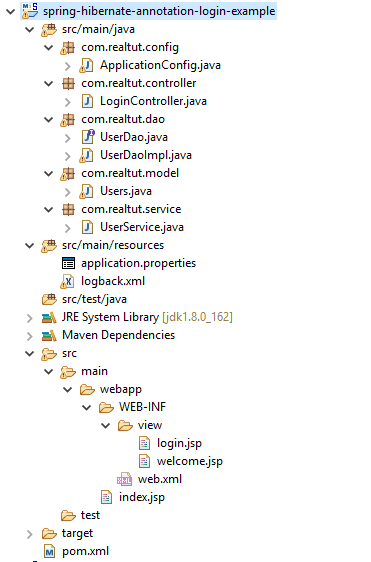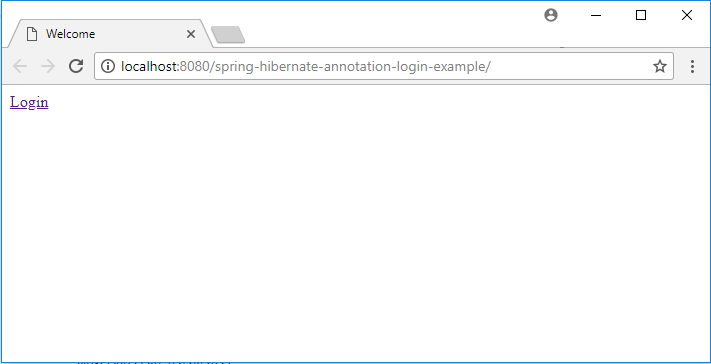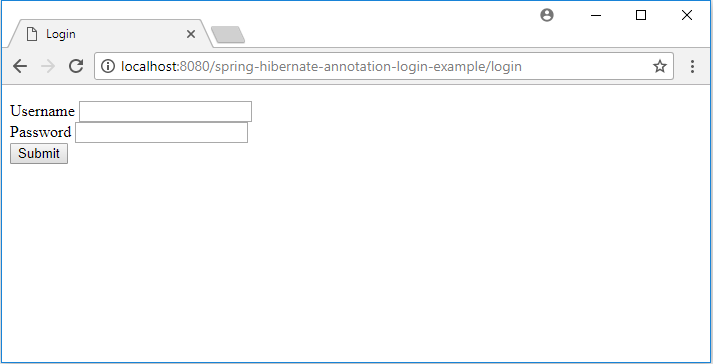Nội dung chính
- Các công nghệ sử dụng trong ví dụ này:
- Cấu trúc project ví dụ login trong Spring Web MVC - Hibernate XML Mapping
-
Create Spring Web MVC - Hibernate Login Example Project
- 1. Create project "spring-hibernate-annotation-login-example"
- 2. Create table users
- 3. Create model Users
- 4. Create UserDao interface
- 5. Create UserDaoImpl class
- 6. Create UserService class
- 7. Update web.xml
- 8. Spring annotation configuration class
- 9. Create file application.properties
- 10. Crreate Login Controller
- 11. Create pages
- Run Spring - Hibernate login example project
Các công nghệ sử dụng trong ví dụ này:
- Eclipse Oxygen 4.7
- MySQL 10.1.29-MariaDB (from xampp-win32-7.2.0-0-VC15-installer)
- JDK 1.8
- Spring 4.3.6.RELEASE
- Hibernate 4.3.11.Final
Cấu trúc project ví dụ login trong Spring Web MVC - Hibernate XML Mapping

Create Spring Web MVC - Hibernate Login Example Project
1. Create project "spring-hibernate-annotation-login-example"
You can use STS Spring Tool Suite (STS) eclipse plugin to create spring web mvc project, this tool will create necessary configuration files. Refer to tutorial Install Spring Tool Suite (STS) in Eclipse.
Update pom.xml file:
<project xmlns="http://maven.apache.org/POM/4.0.0"
xmlns:xsi="http://www.w3.org/2001/XMLSchema-instance"
xsi:schemaLocation="http://maven.apache.org/POM/4.0.0
http://maven.apache.org/xsd/maven-4.0.0.xsd">
<modelVersion>4.0.0</modelVersion>
<groupId>org.springframework.samples.service.service</groupId>
<artifactId>spring-hibernate-annotation-login-example</artifactId>
<version>0.0.1-SNAPSHOT</version>
<packaging>war</packaging>
<properties>
<!-- Generic properties -->
<java.version>1.8</java.version>
<project.build.sourceEncoding>UTF-8</project.build.sourceEncoding>
<project.reporting.outputEncoding>UTF-8</project.reporting.outputEncoding>
<!-- Web -->
<jsp.version>2.2</jsp.version>
<jstl.version>1.2</jstl.version>
<servlet.version>2.5</servlet.version>
<!-- Spring -->
<spring-framework.version>4.3.6.RELEASE</spring-framework.version>
<!-- Hibernate / JPA -->
<hibernate.version>4.3.11.Final</hibernate.version>
<!-- MySQL JDBC Connector -->
<mysql.jdbc.version>5.1.32</mysql.jdbc.version>
<!-- Logging -->
<log4j.version>1.2.17</log4j.version>
<!-- Test -->
<junit.version>4.11</junit.version>
</properties>
<dependencies>
<!-- Spring MVC -->
<dependency>
<groupId>org.springframework</groupId>
<artifactId>spring-webmvc</artifactId>
<version>${spring-framework.version}</version>
</dependency>
<dependency>
<groupId>org.springframework</groupId>
<artifactId>spring-core</artifactId>
<version>${spring-framework.version}</version>
</dependency>
<dependency>
<groupId>org.springframework</groupId>
<artifactId>spring-context</artifactId>
<version>${spring-framework.version}</version>
</dependency>
<dependency>
<groupId>org.springframework</groupId>
<artifactId>spring-tx</artifactId>
<version>${spring-framework.version}</version>
</dependency>
<dependency>
<groupId>org.springframework</groupId>
<artifactId>spring-orm</artifactId>
<version>${spring-framework.version}</version>
</dependency>
<dependency>
<groupId>org.springframework</groupId>
<artifactId>spring-jdbc</artifactId>
<version>${spring-framework.version}</version>
</dependency>
<!-- Hibernate -->
<dependency>
<groupId>org.hibernate</groupId>
<artifactId>hibernate-entitymanager</artifactId>
<version>${hibernate.version}</version>
</dependency>
<dependency>
<groupId>org.hibernate</groupId>
<artifactId>hibernate-core</artifactId>
<version>${hibernate.version}</version>
</dependency>
<dependency>
<groupId>org.javassist</groupId>
<artifactId>javassist</artifactId>
<version>3.18.2-GA</version>
</dependency>
<!-- MySQL driver -->
<dependency>
<groupId>mysql</groupId>
<artifactId>mysql-connector-java</artifactId>
<version>${mysql.jdbc.version}</version>
</dependency>
<!-- Other Web dependencies -->
<dependency>
<groupId>javax.servlet</groupId>
<artifactId>jstl</artifactId>
<version>${jstl.version}</version>
</dependency>
<dependency>
<groupId>javax.servlet</groupId>
<artifactId>servlet-api</artifactId>
<version>${servlet.version}</version>
<scope>provided</scope>
</dependency>
<dependency>
<groupId>javax.servlet.jsp</groupId>
<artifactId>jsp-api</artifactId>
<version>${jsp.version}</version>
<scope>provided</scope>
</dependency>
<!-- Log4j -->
<dependency>
<groupId>log4j</groupId>
<artifactId>log4j</artifactId>
<version>${log4j.version}</version>
</dependency>
<!-- Test Artifacts -->
<dependency>
<groupId>org.springframework</groupId>
<artifactId>spring-test</artifactId>
<version>${spring-framework.version}</version>
<scope>test</scope>
</dependency>
<dependency>
<groupId>junit</groupId>
<artifactId>junit</artifactId>
<version>${junit.version}</version>
<scope>test</scope>
</dependency>
</dependencies>
</project>
2. Create table users
CREATE TABLE users (
id INT NOT NULL auto_increment,
username VARCHAR(30) default NULL,
password VARCHAR(32) default NULL,
PRIMARY KEY (id)
);
INSERT INTO users('username', 'password') VALUES ("admin", "12345678");
3. Create model Users
Create model Users in package com.realtut.model.
File: Users.java
package com.realtut.model;
import javax.persistence.Column;
import javax.persistence.Entity;
import javax.persistence.GeneratedValue;
import static javax.persistence.GenerationType.IDENTITY;
import javax.persistence.Id;
import javax.persistence.Table;
@Entity
@Table(name = "users", catalog = "testdb")
public class Users implements java.io.Serializable {
private Integer id;
private String username;
private String password;
public Users() {
}
public Users(String username, String password) {
this.username = username;
this.password = password;
}
@Id
@GeneratedValue(strategy = IDENTITY)
@Column(name = "id", unique = true, nullable = false)
public Integer getId() {
return this.id;
}
public void setId(Integer id) {
this.id = id;
}
@Column(name = "username", length = 30)
public String getUsername() {
return this.username;
}
public void setUsername(String username) {
this.username = username;
}
@Column(name = "password", length = 32)
public String getPassword() {
return this.password;
}
public void setPassword(String password) {
this.password = password;
}
}
4. Create UserDao interface
File: UserDao.java
package com.realtut.dao;
import com.realtut.model.Users;
public interface UserDao {
public Users findByUserName(String username);
}
5. Create UserDaoImpl class
File: UserDaoImpl .java
package com.realtut.dao;
import java.util.ArrayList;
import java.util.List;
import org.hibernate.HibernateException;
import org.hibernate.Session;
import org.hibernate.SessionFactory;
import org.springframework.beans.factory.annotation.Autowired;
import org.springframework.stereotype.Repository;
import com.realtut.model.Users;
@Repository
public class UserDaoImpl implements UserDao {
@Autowired
private SessionFactory sessionFactory;
public Users findByUserName(String username) {
Session session = null;
try {
session = sessionFactory.openSession();
List<Users> users = new ArrayList<Users>();
users = session.createQuery("from Users where username=?")
.setParameter(0, username).list();
if (users.size() > 0) {
return users.get(0);
}
} catch (HibernateException e) {
e.printStackTrace();
}
return null;
}
public SessionFactory getSessionFactory() {
return sessionFactory;
}
public void setSessionFactory(SessionFactory sessionFactory) {
this.sessionFactory = sessionFactory;
}
}
6. Create UserService class
File: UserService.java
package com.realtut.service;
import org.springframework.beans.factory.annotation.Autowired;
import org.springframework.stereotype.Service;
import com.realtut.dao.UserDao;
import com.realtut.model.Users;
@Service("userService")
public class UserService {
@Autowired
private UserDao userDao;
public boolean isUsers(String username, String password) {
Users user = userDao.findByUserName(username);
if (user != null && user.getPassword().equals(password)) {
return true;
}
return false;
}
public UserDao getUserDao() {
return userDao;
}
public void setUserDao(UserDao userDao) {
this.userDao = userDao;
}
}
7. Update web.xml
File: web.xml
<?xml version="1.0" encoding="UTF-8"?>
<web-app xmlns:xsi="http://www.w3.org/2001/XMLSchema-instance"
xmlns="http://java.sun.com/xml/ns/javaee"
xsi:schemaLocation="http://java.sun.com/xml/ns/javaee
http://java.sun.com/xml/ns/javaee/web-app_2_5.xsd"
id="WebApp_ID" version="2.5">
<display-name>spring-hibernate-annotation-login-example</display-name>
<listener>
<listener-class>org.springframework.web.context.ContextLoaderListener</listener-class>
</listener>
<!-- annotated that this application is config by annotation, instead of default
by xml -->
<context-param>
<param-name>contextClass</param-name>
<param-value>org.springframework.web.context.support.AnnotationConfigWebApplicationContext</param-value>
</context-param>
<!-- indicate spring annotation configuration class -->
<context-param>
<param-name>contextConfigLocation</param-name>
<param-value>com.realtut.config.ApplicationConfig</param-value>
</context-param>
<!-- - Servlet that dispatches request to registered handlers (Controller implementations). -->
<servlet>
<servlet-name>dispatcherServlet</servlet-name>
<servlet-class>org.springframework.web.servlet.DispatcherServlet</servlet-class>
<init-param>
<param-name>contextConfigLocation</param-name>
<param-value></param-value>
</init-param>
<load-on-startup>1</load-on-startup>
</servlet>
<servlet-mapping>
<servlet-name>dispatcherServlet</servlet-name>
<url-pattern>/</url-pattern>
</servlet-mapping>
</web-app>
8. Spring annotation configuration class
File: ApplicationConfig.java
package com.realtut.config;
import java.io.IOException;
import java.util.Properties;
import org.hibernate.SessionFactory;
import org.springframework.beans.factory.annotation.Autowired;
import org.springframework.context.annotation.Bean;
import org.springframework.context.annotation.ComponentScan;
import org.springframework.context.annotation.Configuration;
import org.springframework.context.annotation.PropertySource;
import org.springframework.core.env.Environment;
import org.springframework.jdbc.datasource.DriverManagerDataSource;
import org.springframework.orm.hibernate4.HibernateTransactionManager;
import org.springframework.orm.hibernate4.LocalSessionFactoryBean;
import org.springframework.web.servlet.config.annotation.EnableWebMvc;
import org.springframework.web.servlet.view.InternalResourceViewResolver;
import org.springframework.web.servlet.view.JstlView;
import com.realtut.dao.UserDaoImpl;
@EnableWebMvc
@Configuration
@ComponentScan(basePackages = { "com.realtut" })
@PropertySource("classpath:application.properties")
public class ApplicationConfig {
@Autowired
Environment evn;
@Bean
public InternalResourceViewResolver viewResolver() {
InternalResourceViewResolver viewResolver = new InternalResourceViewResolver();
viewResolver.setViewClass(JstlView.class);
viewResolver.setPrefix("/WEB-INF/view/");
viewResolver.setSuffix(".jsp");
return viewResolver;
}
@Bean
public DriverManagerDataSource dataSource() throws IOException {
DriverManagerDataSource dataSource = new DriverManagerDataSource();
dataSource.setDriverClassName(evn.getProperty("jdbc.driverClassName"));
dataSource.setUrl(evn.getProperty("jdbc.url"));
dataSource.setUsername(evn.getProperty("jdbc.username"));
dataSource.setPassword(evn.getProperty("jdbc.password"));
return dataSource;
}
@Bean
public LocalSessionFactoryBean sessionFactory() throws IOException {
LocalSessionFactoryBean sessionFactory = new LocalSessionFactoryBean();
sessionFactory.setDataSource(dataSource());
sessionFactory.setPackagesToScan(new String[] { "com.realtut.model" });
sessionFactory.setHibernateProperties(hibernateProperties());
return sessionFactory;
}
@Bean
@Autowired
public HibernateTransactionManager transactionManager(SessionFactory sessionFactory) {
HibernateTransactionManager txManager = new HibernateTransactionManager();
txManager.setSessionFactory(sessionFactory);
return txManager;
}
@Bean
@Autowired
public UserDaoImpl userDao(SessionFactory sessionFactory) {
UserDaoImpl userDao = new UserDaoImpl();
userDao.setSessionFactory(sessionFactory);
return userDao;
}
Properties hibernateProperties() {
return new Properties() {
{
setProperty("hibernate.dialect", evn.getProperty("hibernate.dialect"));
setProperty("hibernate.format_sql", evn.getProperty("hibernate.format_sql"));
setProperty("hibernate.show_sql", evn.getProperty("hibernate.show_sql"));
}
};
}
}
9. Create file application.properties
This file defines database information.
File: application.properties
jdbc.driverClassName=com.mysql.jdbc.Driver jdbc.url=jdbc:mysql://localhost:3306/testdb jdbc.username=root jdbc.password=1234567890 hibernate.dialect=org.hibernate.dialect.MySQL5Dialect hibernate.format_sql=true hibernate.show_sql=true
10. Crreate Login Controller
File: LoginController.java
package com.realtut.controller;
import javax.servlet.http.HttpServletRequest;
import javax.servlet.http.HttpServletResponse;
import org.apache.log4j.Logger;
import org.springframework.beans.factory.annotation.Autowired;
import org.springframework.stereotype.Controller;
import org.springframework.web.bind.annotation.ModelAttribute;
import org.springframework.web.bind.annotation.RequestMapping;
import org.springframework.web.bind.annotation.RequestMethod;
import org.springframework.web.servlet.ModelAndView;
import com.realtut.model.Users;
import com.realtut.service.UserService;
@Controller
public class LoginController {
private static final Logger logger = Logger.getLogger(LoginController.class.getName());
@Autowired
UserService userService;
/**
* show login
*
* @author realtut
* @param request
* @param response
* @return
*/
@RequestMapping(value = "/login", method = RequestMethod.GET)
public ModelAndView showLogin(HttpServletRequest request, HttpServletResponse response) {
logger.info("Request Login.");
ModelAndView view = new ModelAndView("login");
Users loginBean = new Users();
view.addObject("loginBean", loginBean);
logger.info("Open login page.");
return view;
}
/**
* execute login
*
* @author realtut
* @param request
* @param response
* @param loginBean
* @return
*/
@RequestMapping(value = "/login", method = RequestMethod.POST)
public ModelAndView executeLogin(HttpServletRequest request, HttpServletResponse response,
@ModelAttribute("loginBean") Users loginBean) {
ModelAndView view = null;
if (userService.isUsers(loginBean.getUsername(), loginBean.getPassword())) {
request.setAttribute("loggedInUser", loginBean.getUsername());
view = new ModelAndView("welcome");
} else {
request.setAttribute("message", "Invalid ussename or password!");
view = new ModelAndView("login");
}
return view;
}
}
11. Create pages
File: src/main/webapp/WEB-INF/index.jsp
<!DOCTYPE html>
<%@ page language="java" contentType="text/html; charset=UTF-8" pageEncoding="UTF-8"%>
<%@ taglib prefix="c" uri="http://java.sun.com/jsp/jstl/core"%>
<%@ taglib prefix="form" uri="http://www.springframework.org/tags/form"%>
<html>
<head>
<meta charset="utf-8">
<title>Welcome</title>
</head>
<body>
<c:url value="/login" var="messageUrl" />
<a href="${messageUrl}">Login</a>
</body>
</html>
File: src/main/webapp/WEB-INF/view/login.jsp
<!DOCTYPE html>
<%@ page language="java" contentType="text/html; charset=UTF-8" pageEncoding="UTF-8"%>
<%@ taglib prefix="c" uri="http://java.sun.com/jsp/jstl/core"%>
<%@ taglib prefix="form" uri="http://www.springframework.org/tags/form"%>
<html>
<head>
<meta charset="utf-8">
<title>Login</title>
</head>
<body>
<p style="color: red">${message}</p>
<form:form id="loginForm" action="login" method="POST" modelAttribute="loginBean">
<form:label path="username">Username</form:label>
<form:input id="username" name="username" path="username" />
<br>
<form:label path="username">Password</form:label>
<form:password id="password" name="password" path="password" />
<br>
<input type="submit" value="Submit" />
</form:form>
</body>
</html>
File: src/main/webapp/WEB-INF/view/welcome.jsp
<!DOCTYPE html>
<%@ page language="java" contentType="text/html; charset=UTF-8" pageEncoding="UTF-8"%>
<%@ taglib prefix="c" uri="http://java.sun.com/jsp/jstl/core"%>
<%@ taglib prefix="form" uri="http://www.springframework.org/tags/form"%>
<html>
<head>
<meta charset="utf-8">
<title>Welcome</title>
</head>
<body>
<h2>Hello, ${loggedInUser}</h2>
</body>
</html>
Run Spring - Hibernate login example project
Home page:

Login page:

Login error:

Login success:

Dowload Source Code
References
Spring Annotation Type ConfigurationSpring document @Repository, @Component, @Service, and @Controller

